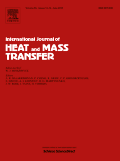
INTERNATIONAL JOURNAL OF HEAT AND MASS TRANSFER
Scope & Guideline
Pioneering Discoveries in Condensed Matter Physics
Introduction
Aims and Scopes
- Heat Transfer Mechanisms:
The journal covers various mechanisms of heat transfer, including conduction, convection, and radiation, emphasizing their applications in engineering and technology. - Mass Transfer Processes:
Research related to mass transfer phenomena, including diffusion, adsorption, and absorption, is a core focus, particularly in relation to energy systems and environmental processes. - Thermal Management Systems:
Studies on thermal management strategies for electronics, batteries, and other systems are prevalent, highlighting the importance of efficient heat dissipation. - Phase Change Materials (PCMs):
The journal features research on PCMs for thermal energy storage, focusing on their thermal performance, integration, and optimization in various applications. - Numerical and Experimental Methods:
A significant emphasis is placed on both numerical simulations and experimental studies, with many articles presenting hybrid approaches that combine theory and practice. - Innovative Thermal Technologies:
The journal explores advancements in thermal technologies, such as heat exchangers, cooling systems, and thermal insulation materials, showcasing novel designs and methodologies. - Multiscale Modeling and Analysis:
Research that integrates multiscale modeling approaches to understand complex thermal and fluid dynamics phenomena is increasingly prominent.
Trending and Emerging
- Nanofluid Applications:
Research on nanofluids, particularly their thermal properties and applications in heat exchangers and cooling systems, is gaining traction due to their enhanced performance. - Machine Learning in Heat Transfer:
The integration of machine learning techniques for predictive modeling and optimization in heat transfer applications is an emerging trend, reflecting the growing intersection of AI and engineering. - Sustainable Thermal Management Solutions:
There is an increasing focus on sustainable and energy-efficient thermal management solutions, including the use of phase change materials and innovative cooling technologies. - Advanced Materials for Heat Transfer:
Research on advanced materials, such as metamaterials and nanostructured surfaces, is trending, particularly for applications in thermal management and energy efficiency. - Electrohydrodynamic (EHD) Effects:
The exploration of EHD effects on heat transfer and fluid dynamics is becoming more prominent, indicating a shift towards understanding complex interactions in thermal systems. - Thermal Energy Storage Systems:
There is a growing interest in thermal energy storage technologies, particularly those utilizing phase change materials and hybrid systems, to improve energy efficiency.
Declining or Waning
- Traditional Heat Exchanger Designs:
There has been a noticeable decline in studies focusing solely on conventional heat exchanger designs, as research shifts towards more innovative and hybrid systems. - Simple Convection Studies:
Research centered on basic convection phenomena is decreasing, with more complex interactions in turbulent and multiphase flows gaining attention. - Basic Heat Transfer Theory:
Papers focusing on fundamental heat transfer theory without practical applications or novel insights seem less common, as the field moves towards applied research. - Single-Phase Flow Studies:
There is a waning interest in single-phase flow studies, with a noticeable shift towards investigations involving multiphase flows and their complex interactions. - Conventional Thermal Insulation Materials:
Research on traditional thermal insulation materials is becoming less frequent as newer materials and technologies, such as aerogels and biomimetic designs, take precedence.
Similar Journals
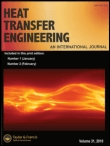
HEAT TRANSFER ENGINEERING
Transforming concepts into cutting-edge thermal applications.HEAT TRANSFER ENGINEERING is a leading international journal published by Taylor & Francis Inc, dedicated to advancing the field of heat transfer and thermal engineering. With a strong focus on the key aspects of Condensed Matter Physics, Fluid Flow and Transfer Processes, and Mechanical Engineering, this journal covers a comprehensive range of topics from experimental studies to theoretical analysis, aiming to foster innovative research and practical applications. Since its inception in 1979 and continuing through 2024, the journal has established itself as an essential resource for researchers and industry professionals alike, reflected in its solid rankings within Scopus—holding a Q2 quartile classification in multiple engineering disciplines. Although not open access, the journal ensures broad accessibility through institutional subscriptions, making cutting-edge research readily available. With its rigorous peer-review process and commitment to quality, HEAT TRANSFER ENGINEERING plays a crucial role in shaping the future of thermal management solutions and engineering practices.

Heat Transfer
Innovating heat transfer research for real-world applications.Heat Transfer, published by WILEY, is a leading open-access journal dedicated to advancing the field of heat transfer science, encompassing innovative research and application across various domains. With an ISSN of 2688-4534 and an E-ISSN of 2688-4542, the journal aims to provide a platform for researchers to disseminate their findings from 2020 to 2024, focusing on condensed matter physics and fluid dynamics. Ranked in the Q2 category for both Condensed Matter Physics and Fluid Flow and Transfer Processes, it showcases articles that contribute significantly to the understanding and utilization of heat transfer mechanisms. Located in the United States at 111 River St, Hoboken, NJ 07030, the journal appeals to a diverse audience, including academic researchers, professionals in engineering, and students seeking to deepen their knowledge in thermal sciences. With a strong emphasis on accessibility, Heat Transfer promotes the exchange of ideas and experimental techniques, ultimately driving innovation and collaboration in the advancement of thermal management technologies.

Journal of Engineering Thermophysics
Catalyzing breakthroughs in thermal dynamics and engineering applications.Journal of Engineering Thermophysics, published by PLEIADES PUBLISHING INC, is a premier academic journal dedicated to advancing the field of thermophysics and its applications across a variety of engineering disciplines. With an ISSN of 1810-2328 and an E-ISSN of 1990-5432, this journal offers an essential platform for researchers and professionals to disseminate cutting-edge findings on the interplay between thermal processes and engineering systems. As of 2023, it is recognized within the Q3 category in key fields such as Condensed Matter Physics, Energy Engineering and Power Technology, Environmental Engineering, and Modeling and Simulation. Moreover, the journal contributes to an important dialogue in the environmental sciences, ranking 111 out of 197 in Environmental Engineering, and positions itself prominently within the academic landscape from its establishment in 2007. Although currently not an open-access journal, it facilitates a selective yet impactful communication of research that drives innovation and knowledge in the thermal sciences. For those engaged in understanding the thermal dynamics essential for sustainable engineering solutions, the Journal of Engineering Thermophysics is the go-to resource for published research, reviews, and advancements in the field.

HEAT TRANSFER RESEARCH
Shaping the Future of Mechanical Engineering ResearchHEAT TRANSFER RESEARCH is a leading academic journal published by Begell House Inc that focuses on the dynamic and evolving fields of heat transfer, fluid flow, and mechanical engineering. With an ISSN of 1064-2285 and an E-ISSN of 2162-6561, this journal serves as a critical platform for researchers and professionals seeking to disseminate innovative findings and advancements in these interrelated disciplines. Covering converged years from 1992 to 2024, HEAT TRANSFER RESEARCH has established its impact in the academic community, achieving a 2023 ranking of Q3 in Condensed Matter Physics and Q2 in Fluid Flow and Transfer Processes. It currently occupies a percentile rank ranging from 44th to 54th across several Scopus categories, underscoring its relevance and contribution to the scientific discourse. While Open Access options are not available, the journal remains committed to providing high-quality research and insights that shape the future of thermal sciences. Accessible to both seasoned professionals and aspiring students, HEAT TRANSFER RESEARCH is indispensable for anyone looking to stay ahead in the ever-changing landscape of engineering and applied physics.
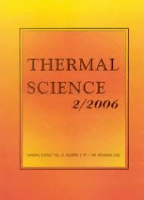
Thermal Science
Unveiling the science behind renewable energy systems and their impact.Thermal Science is an esteemed open-access journal published by the Vinca Institute of Nuclear Sciences in Serbia. With a rich focus on the field of thermal science, this journal has established itself as a vital resource for researchers and professionals interested in the dynamics of energy, renewable energy systems, and environmental sustainability. Since its inception in 2001, Thermal Science has dedicated itself to disseminating high-quality research that addresses the challenges of contemporary thermal technologies. The journal has converged its years of publication from 2007 to 2024 and currently holds a Q4 ranking in the category of Renewable Energy, Sustainability, and the Environment, with a Scopus rank of #172 out of 270, placing it in the 36th percentile. This makes it a crucial platform for sharing innovations and findings that contribute to the development of sustainable energy solutions. With open access options available, Thermal Science ensures that knowledge is readily accessible, fostering collaboration and advancement in this critical field.

JOURNAL OF POROUS MEDIA
Connecting Researchers Across Diverse DisciplinesJOURNAL OF POROUS MEDIA is a prominent interdisciplinary journal published by Begell House Inc, focusing on the advancement of knowledge related to porous media across various fields, including Biomedical Engineering, Condensed Matter Physics, Materials Science, and Mechanical Engineering. With its ISSN 1091-028X and E-ISSN 1934-0508, this journal serves as a vital platform for researchers and professionals to disseminate groundbreaking findings and foster collaboration within the scientific community. The journal is ranked in the Q2 and Q3 quartiles in multiple categories as of 2023, demonstrating a notable standing in Scopus rankings across several engineering and physics disciplines. Though not an open-access journal, it provides essential insights and advancements within the field of porous media research, encouraging innovative exploration and practical applications in real-world scenarios. Published from 1998 through 2024, JOURNAL OF POROUS MEDIA is an invaluable resource for students, researchers, and industry experts seeking to deepen their understanding of complex porous systems.
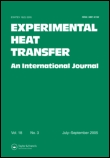
EXPERIMENTAL HEAT TRANSFER
Advancing Thermal InnovationEXPERIMENTAL HEAT TRANSFER, published by Taylor & Francis Inc, is a leading journal in the fields of heat transfer, control and systems engineering, and instrumentation, with a strong impact factor evidenced by its placement in the second quartile (Q2) for relevant categories as of 2023. With ISSN 0891-6152 and E-ISSN 1521-0480, the journal has been an essential platform for researchers since its inception in 1987, facilitating the dissemination of innovative research, experimental methods, and advancements in thermal engineering. This journal, based in the United Kingdom, focuses on both applied and theoretical aspects of heat transfer, engaging a diverse audience of professionals and students keen on the latest scientific breakthroughs in the domain. With its solid Scopus rankings, including being in the top 76th percentile in Physics and Astronomy: Instrumentation, EXPERIMENTAL HEAT TRANSFER continues to be a vital resource for advancing knowledge and fostering collaboration among the academic community.
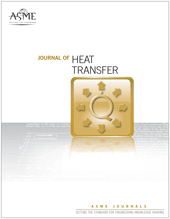
JOURNAL OF HEAT TRANSFER-TRANSACTIONS OF THE ASME
Connecting Researchers to the Heart of Heat Transfer.JOURNAL OF HEAT TRANSFER-TRANSACTIONS OF THE ASME, with ISSN 0022-1481 and E-ISSN 1528-8943, is a leading publication in the field of heat transfer, mechanical engineering, and related disciplines, published by the renowned American Society of Mechanical Engineers (ASME). This esteemed journal, which has been in circulation since 1945, provides a platform for novel research findings and reviews that the mechanical engineering community can rely upon, contributing significantly to the advancement of knowledge in heat transfer processes. The journal is recognized for maintaining a strong impact in several categories, attaining Q2 quartile rankings in Condensed Matter Physics, Mechanical Engineering, and Mechanics of Materials, reflecting its influential role in shaping scientific dialogues. With a commendable Scopus ranking, including a percentile of 63rd in Mechanical Engineering, it attracts submissions from leading researchers and industry professionals alike. Although access options are currently undergoing changes, the commitment to disseminating cutting-edge research remains steadfast. Gathering insights from historical and contemporary studies, the JOURNAL OF HEAT TRANSFER stands as a vital resource for those aiming to innovate in heat transfer technologies and methodologies.

Case Studies in Thermal Engineering
Unlocking Insights Through Innovative Case StudiesCase Studies in Thermal Engineering, published by ELSEVIER, stands as a premier platform for innovative research and analysis in the field of thermal engineering since its inception in 2013. With a robust Open Access model, this journal ensures that groundbreaking findings in fluid flow and transfer processes are readily accessible to a global audience, fostering collaboration and knowledge sharing across disciplines. Situated in the United Kingdom, the journal boasts an impressive impact factor, reflecting its status in the first quartile (Q1) for both engineering (miscellaneous) and fluid flow and transfer processes, as noted in the latest Scopus rankings. Researchers and professionals alike recognize its significance, ranking 9th out of 96 in Chemical Engineering and achieving a notable 91st percentile in its category. By publishing high-quality case studies, the journal aims to advance understanding and applications of thermal engineering principles, making it an essential resource for those looking to stay at the forefront of this dynamic field.

Frontiers in Heat and Mass Transfer
Empowering the Future of Engineering and Materials ScienceFrontiers in Heat and Mass Transfer is a premier open-access journal published by TECH SCIENCE PRESS that focuses on the interdisciplinary field of heat and mass transfer. Established in 2010, this journal has been pivotal in disseminating high-quality research aimed at advancing the understanding of energy and material transport phenomena. With an impressive commitment to open access, it ensures that all published articles are readily available to researchers, practitioners, and students globally, promoting knowledge sharing and collaboration. The journal currently holds a Q3 ranking in key categories such as Engineering, Materials Science, and Physics and Astronomy, as well as notable positioning in Scopus rankings. With a forward-looking scope extending from 2010 to 2024, Frontiers in Heat and Mass Transfer continues to be an essential platform for innovative research, fostering the development of practical applications across various scientific and engineering domains. We invite you to explore the latest contributions to this evolving field and consider this journal as a vital resource for your academic and professional growth.